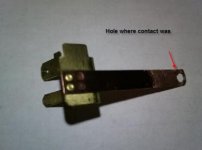crossthread
Titanium
- Joined
- Aug 5, 2004
- Location
- Richmond,VA,USA
This is sort of OT but it does pertain to machining somewhat. I have a Samsung dryer that would not start but would run when you gave the drum a push. Start winding, capacitor or something like that for sure. I pulled it apart and found a start switch mounted on the side of the motor which is activated by a centrifugal mechanism. Pulled the switch apart and the contact is gone but the beryllium strip is still intact with just a hole in it where the contact was. Samsung in all there eminent wisdom does not sell just the switch but requires that you buy the entire motor assembly for a couple of hundred dollars. I being old school who adheres to the premise that I can fix anything but a broken heart, want to replace the contact. My question is this: will copper work? I could turn one out of silver but that means I will need to come up with a small piece of silver bar stock. The hole in the strip looks just about as big as a piece of #12 solid copper wire. Easy to put in there and upset it on both sides. I did some looking around and it seems most contacts are either "fine" silver or some other exotic alloy. Will copper hold up? Thanks very much for any information.


 ) I would cut the existing strip square and solder the new strip with contact.
) I would cut the existing strip square and solder the new strip with contact.